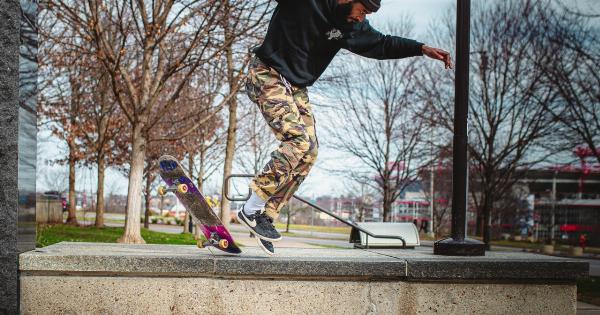As we age, our bodies undergo various changes, and one common challenge faced by many individuals as they approach middle age is incontinence. Incontinence refers to the loss of bladder or bowel control, leading to involuntary leakage.
This condition can be embarrassing and affect a person’s confidence and quality of life. However, there are several strategies and coping mechanisms that can help individuals manage incontinence effectively and regain control over their lives.
Understanding Incontinence
Before diving into coping mechanisms, it is essential to understand the different types of incontinence that one might experience:.
1. Stress Incontinence
Stress incontinence occurs when there is pressure exerted on the bladder, leading to leakage. This pressure can be the result of activities such as coughing, sneezing, laughing, or even lifting heavy objects.
2. Urge Incontinence
Urge incontinence, also known as overactive bladder, involves a sudden and intense urge to urinate, followed by involuntary leakage.
Individuals with urge incontinence often experience frequent trips to the bathroom and may find it difficult to reach the toilet in time.
3. Overflow Incontinence
Overflow incontinence occurs when the bladder doesn’t empty completely, causing it to overflow. This can result in a constant dribbling of urine. It is often caused by an obstruction or weakened bladder muscles.
4. Functional Incontinence
Functional incontinence is not directly related to bladder or bowel issues but rather to physical or cognitive impairments that make it challenging to reach the bathroom in time.
Conditions such as arthritis or dementia can contribute to functional incontinence.
Identifying the Underlying Causes
In order to cope effectively with incontinence, it is crucial to identify the underlying causes. Common causes of incontinence in middle age include:.
1. Hormonal Changes
During middle age, hormonal shifts, particularly in women going through menopause, can lead to bladder control issues.
Estrogen plays a vital role in maintaining the health and strength of the urinary tract muscles, and its decline can result in incontinence symptoms.
2. Weak Pelvic Floor Muscles
The pelvic floor muscles support the bladder and help control urination. As we age, these muscles can weaken, leading to bladder control problems. Childbirth, obesity, and certain medical conditions can also contribute to weakened pelvic floor muscles.
3. Enlarged Prostate
In men, an enlarged prostate gland can compress the urethra, resulting in a weak urine flow and difficulty emptying the bladder completely. This can cause overflow incontinence or urge incontinence.
4. Chronic Illnesses
Conditions such as diabetes, Parkinson’s disease, multiple sclerosis, and stroke can interfere with the nerves and muscles involved in bladder control, leading to incontinence issues.
Lifestyle Changes to Manage Incontinence
While incontinence can be challenging to deal with, several lifestyle changes can significantly improve one’s ability to manage and cope with this condition:.
1. Maintain a Healthy Weight
Being overweight can put added pressure on the bladder, increasing the chances of leakage. Engage in regular physical activity and follow a balanced diet to maintain a healthy weight and reduce strain on the bladder.
2. Stay Hydrated, But Watch Your Fluid Intake
Proper hydration is important for overall health, including urinary health. However, consuming excessive fluids, especially before bedtime, can worsen incontinence symptoms. It is essential to strike a balance and spread fluid intake throughout the day.
3. Practice Pelvic Floor Exercises
Strengthening the pelvic floor muscles through exercises known as Kegels can improve bladder control and reduce leakage. These exercises involve contracting and releasing the muscles used to stop the flow of urine.
Aim for at least three sets of 10 repetitions daily.
4. Avoid Bowel Constipation
Constipation can put pressure on the bladder and exacerbate incontinence symptoms. Ensure you have a diet rich in fiber, stay hydrated, and engage in regular exercise to keep your bowels regular and prevent constipation.
Medical Interventions for Incontinence
If lifestyle changes alone do not provide sufficient relief, various medical interventions can be considered for managing incontinence:.
1. Medications
Medications can help manage incontinence symptoms by relaxing the bladder muscles, reducing urgency, or increasing bladder capacity. Consult a healthcare professional to determine if medications are appropriate for your specific situation.
2. Bladder Training
Bladder training involves gradually increasing the time intervals between bathroom visits to improve bladder capacity and reduce the frequency of urgency. This technique is particularly effective for individuals with urge incontinence.
3. Electrical Stimulation
Electrical stimulation involves using low-voltage electrical currents to stimulate the nerves responsible for bladder control. This therapy can help strengthen the pelvic floor muscles and improve bladder function.
4. Surgery
In some cases, surgery may be necessary to address the underlying causes of incontinence. Procedures such as sling procedures, bladder neck suspension, or artificial urinary sphincter implantation can provide long-term relief.
Managing Incontinence Psychologically
Living with incontinence can have a significant impact on an individual’s mental and emotional well-being. It is essential to address the psychological aspects of this condition to cope effectively:.
1. Openly Discuss and Seek Support
Talking about incontinence with loved ones, friends, or healthcare professionals can help reduce feelings of isolation and embarrassment.
Seek support groups or online forums where individuals experiencing similar challenges can share their stories and coping strategies.
2. Use Protective Products
Modern incontinence products, such as absorbent pads or adult diapers, can provide a sense of security and help manage leakage effectively. Knowing that you are protected can boost confidence and reduce anxiety about potential accidents.
3. Plan and Prepare for Outings
When going out, it can be helpful to familiarize yourself with the nearest restroom locations in advance. Consider timing your bathroom visits strategically before leaving and wear clothing that allows for easy access when necessary.
4. Practice Stress Management Techniques
Incontinence can cause stress and anxiety, which can, in turn, worsen the symptoms. Engaging in relaxation techniques such as deep breathing exercises, meditation, or yoga can help reduce stress levels and positively impact incontinence control.
Conclusion
While incontinence is a common challenge faced by individuals as they approach middle age, it is essential to understand that it is a manageable condition.
By implementing lifestyle changes, seeking appropriate medical interventions, and addressing the psychological aspects, individuals can effectively cope with incontinence and regain control over their lives. Remember, seeking professional guidance and support is crucial in developing an effective coping strategy that suits individual needs.































